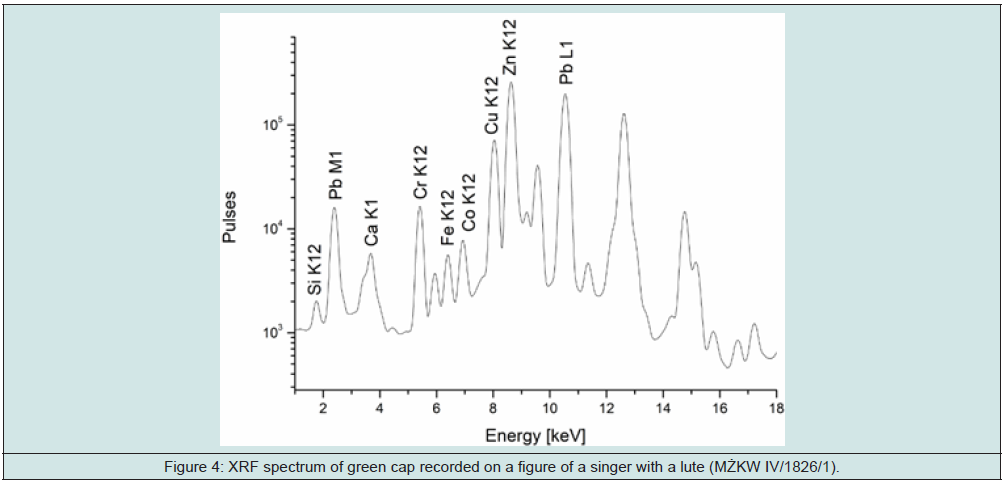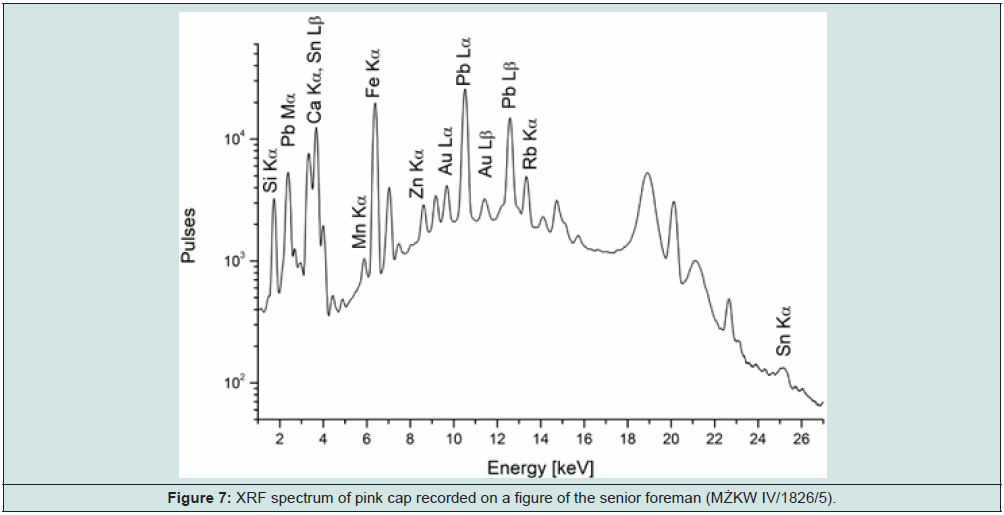
Lupine Publishers Group
Lupine Publishers
Menu
ISSN: 2690-5752
Research Article(ISSN: 2690-5752) 
X-Ray Analysis of Eighteenth-and Nineteenth-Century Meissen Porcelain Figurines Volume 7 - Issue 5
Anna Klisińska Kopacz1*, Tomasz Wilkosz1 and Klementyna Ochniak Dudek2
- 1The Laboratory of Analysis and Nondestructive Investigation of Heritage Objects, The National Museum in Krakow, Krakow, Poland
- 2Cracow Saltworks Museum in Wieliczka, Wieliczka, Poland
Received:January 24, 2023; Published: February 09, 2023
Corresponding author: Anna Klisińska Kopacz, The Laboratory of Analysis and Nondestructive Investigation of Heritage Objects, The National Museum in Krakow, 3 Maja 1 Av, 30-062 Krakow, Poland
DOI: 10.32474/JAAS.2023.07.000271
Abstract
Abstract
The paper presents the results of analysis group of six porcelain figurines from Meissen manufacture. Due to the nature of the objects studied, only non-invasive research could be carried out. In order to characterise the miners’ figurines, their state of preservation and chemical composition, each figurine was subjected to a similar research procedure. In the first stage, visual analyses, photos in ultraviolet (UV) analytical light and X-ray photographs were taken. Then, in order to characterize the pigments present in the paint layer, the elemental composition was measured by X-ray fluorescence spectroscopy (XRF). Thanks to the literature data it was possible to date individual fragments of each object. The information obtained from the physicochemical analysis was evaluated in the context of the data on the provenance and history of the studied objects. The combination of physicochemical analysis and art history information in this multidisciplinary project allowed to learn about the fascinating history of these unique figures. The beauty, craftsmanship, and sophistication of these small works of art provide evidence about their the artistic, cultural, and historical value.
Introduction
When surveying historic artworks, it is accepted that the object should be interfered with as little as possible and, if possible, not sampled. Non-invasive techniques have therefore become increasingly popular in recent years [1-5]. These are particularly helpful in the case of objects from which sampling would affect the integrity of the entire object. This includes objects made of glass, ceramics and porcelain. The European porcelain was produced for the first time in Meissen [6,7]. The factory was established in 1710 through an edict of Augustus the Strong, the King of Poland, and an Elector of Saxony. Meissen porcelain was called “white gold”, competing with products from China and Japan. Porcelain figurines initially decorated the king’s tables, then they became the object of desire of the high society. They are popular to this day and enjoy unflagging interest from collectors.
The collection of the Crakow Saltworks Museum in Wieliczka was expanded in 2019 with a set of six porcelain sculptures of miners, created in a manufactory in Meissen. Four of the six miners’ sculptures examined in this publication belonged in the past to the Dresden banker Gustav von Klemper. His collection, created between the mid 1890s and 1926, included 834 objects and was considered one of the best private collections of Meissen porcelain. The figurines were dated to the 18th century, but in their structure and painted decorations, evidence of conservation treatments and changes were evident. The origin of the other two figurines was unknown [8]. This became a prerequisite for a more detailed diagnosis of porcelain objects. It is known that in the nineteenth century, due to the huge popularity of early Meissen objects, numerous imitations produced by other European porcelain factories appeared. Therefore, scientific research of the technologies used in the manufacture of these objects that could support historical research and allow to confirm their date of production became essential.
Despite the importance of objects made from porcelain in the Meissen manufactory, relatively few publications on scientific research using non-invasive techniques have been published [9-12]. However, research on other types of porcelain objects has also been a valuable source of information on the materials and techniques used to produce porcelain in Europe [13-18]. Due to the state of preservation of the objects, it was only possible to conduct research with the use of non-invasive techniques. To accurately illustrate the tested figures, imaging was conducted using visible and UV radiation. Photographs under UV radiation in many cases revealed uneven fluorescence, which allowed for the determination of the boundaries of conservation, changes, and additions. Then, digital radiography was performed to visualize the internal structure of objects and reveal mechanical failure. In the last phase of the work, the elemental composition of individual areas on the figures was examined using X-ray fluorescence spectroscopy (XRF) in order to determine the materials used in the manufacture and subsequent restoration process and thus date the objects.
Materials and Methods
Objects
The subject of this study is a set of six figurines representing figures of miners currently in the collection of the Cracow Saltworks Museum in Wieliczka. The general appearance of the objects studied is shown in the figure (Figure 1). At the time of their acquisition in 2019, they were identified as being entirely made in the Meissen manufactory, according to models developed around 1750 by J. J. Kaendler. The four sculptures of miners depicting singers playing the lute and triangle, a mining manager, a digger (inv. no. MŻKW IV/1826/1, IV/1826/2, IV/1826/4, IV/1826/6) had in the past belonged to the Dresden banker Gustav von Klemperer. At the end of 1938, the collection was taken over by the German authorities and then incorporated into the state porcelain collection in 1943. It is believed that the most of objects was destroyed in a bombing in 1945. Remnants recovered from the rubble continued to be housed in the State Art Collections in Dresden after the war. In 2010, a fragment of the collection consisting of broken and damaged objects was returned to the heirs, who decided to sell them at auction. In 2014, a group of four Meissen miners was again put up for sale after restoration by the Meissen State Porcelain Manufactory. Four years later, it was most likely auctioned in Vienna, with the four figurines from the G. von Klemperer collection being enhanced by two additional figures of a foreman and a flute miner from the same series, but their provenance remained unknown. The entire set of miners’ figurines was acquired by the Cracow Saltworks Museum in Wieliczka in 2019.
Figure 1: Photographs in visible light (VIS) of figurines: a) MŻKW/1826/1, b) MŻKW/1826/2, c) MŻKW/1826/3, d) MŻKW/1826/4, e) MŻKW/1826/5, f) MŻKW/1826/6.
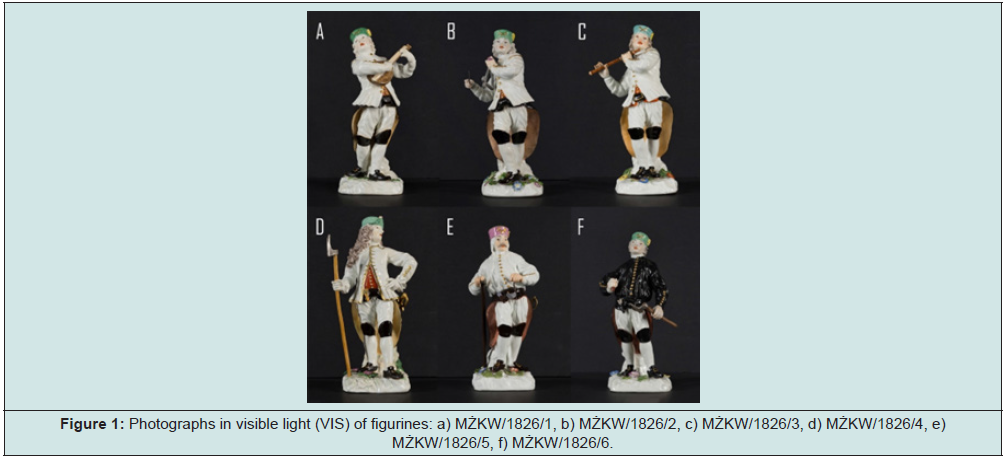
Methods
Photographs of objects were taken in different ranges of electromagnetic radiation. Photographs in visible light (VIS) and ultraviolet (UV)-excited fluorescence were taken with a CANON EOS 5D Mark III camera equipped with a CANON MACRO LENS EF 100 mm, 1:2.8. USM lens. Images in visible light (VIS) were taken with 2x500 W halogen lighting. Exposure parameters were 5.0 sec, f/10, ISO 100. Ultraviolet (UV) excited fluorescence photography was performed using 40 W UV fluorescent lamps, GE F40 Black Light Blue EX, operating at 368 nm. Exposure parameters were 30.0 sec, f/3.2, ISO 100. Radiograms were taken using the DIX-Ray system, which is based on a wireless panel measuring: 46x38cm. Distance of the X-ray tube face from the detector surface: 200cm. Exposure parameters: 40kV, 40mAs. Analyses of elemental composition were carried out with an ARTAX 800 X-ray fluorescence spectrometer (Bruker AXS, DE) equipped with a Peltier-cooled SDD detector, a polycapillary optics system and a Rh lamp as the excitation source. Measurements were carried out at the following parameters: U 40 kV, I 400 μA measurement in air atmosphere, spectrum accumulation time 60 seconds.
Peaks arising from the rhodium (Rh) target anode in the X-ray tube source appeared in all XRF spectra acquired. No energy is lost in this process so peaks show up at characteristic X-ray energies of Rh at 20.2 and 22.7 keV for Kα and Kβ emission lines, respectively. Peaks at 18.9 and 21.7 keV are Compton peaks, which are also derived from the X-ray excitation source. Acquisition and evaluation of XRF spectra was carried out using Spectra 5.3 (Bruker, DE). As a result of the XRF measurement, a spectroscopic spectrum with element-specific energy bands is obtained. It should be noted that the area areas of a given band obtained in the analysis (expressed in conventional units) do not translate directly into the percentage composition of the sample under study. The value of the counts for a given element is generally proportional to the amount of that element in the sample under study, but this relationship is not linear. By comparing several measurement points within the same object, it is only possible to determine whether the content of a given element is changing.
Results and Discussion
General view of all discussed figures is shown in Figure 1. The results of digital radiography are presented in Figure 2. Ultraviolet induced visible fluorescence images can be found in section Supplementary 1.
Figure 2: Digital radiography: a) MŻKW/1826/1, b) MŻKW/1826/2, c) MŻKW/1826/3, d) MŻKW/1826/4, e) MŻKW/1826/5, f) MŻKW/1826/6
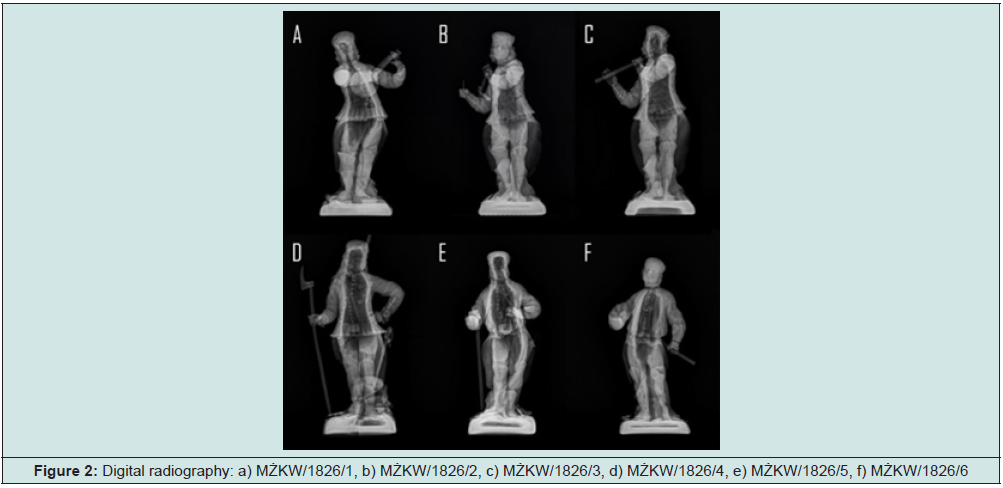
The figure of a singer with a lute
The figurine of a singer with a lute (inv. no. MŻKW IV/1826/1) is the only one in the set in which the Meissen label was not found. Digital radiography revealed internal cracks and repairs to the figurine. Both legs - the right below the knee and the left above the ankle - as well as the corners and back of the pedestal, the left hand on the fretboard of the lute and the forehead with the cap have most likely been reconstructed. Some repairs are also visible in the UV images, such as in the area of the right shoe. The inhomogeneity of the figure visible under ultraviolet light, allows some changes in local luminescence to be observed. This is particularly well visible on the tip of the nose, the pedestal and the hands.
XRF analysis indicated that this figurine was made of white clay with a heterogeneous elemental composition. Most of the white areas examined, such as the face, sleeve, back, leg or front part of the pedestal, are dominated by calcium (Kα 3.6 keV; Kβ 4.0 keV lines), potassium (Kα 3.3 keV line), lead (Lα, Lβ, and Lγ lines at 10.6, 12.6 and 14.8 keV), iron (Kα 6.4 keV; Kβ 7.1 keV lines), and a variable zinc (Kα 8.6 keV; Kβ 9.6 keV lines) content, in addition to silicon (Kα 1.7 keV line). The high zinc content detected in various places such as body, arms, legs, or plinth may suggest the 19th century as the date of the figurine’s creation. [9,18] However, its variable content, much lower on the face and hair compared to the body and legs, is questionable, which may indicate an earlier, 18thcentury origin of the figurine. In the course of several subsequent restorations, the object was probably completely repainted and glazed. Consequently, there is also a slight zinc signal in areas not fully restored (face, hair). In other places, such as the tip of the nose, the back of the plinth or the corner of the pedestal, there is a clear titanium (Kα 4.5 keV; Kβ 4.9 keV lines) signal (Figure 3). The detection of titanium explains the luminescence observed under UV light in these areas.
Figure 3: XRF spectrum of white porcelain recorded on (a) the face (b) the back (c) the tip of the nose of a figure of a singer with a lute (MŻKW IV/1826/1).
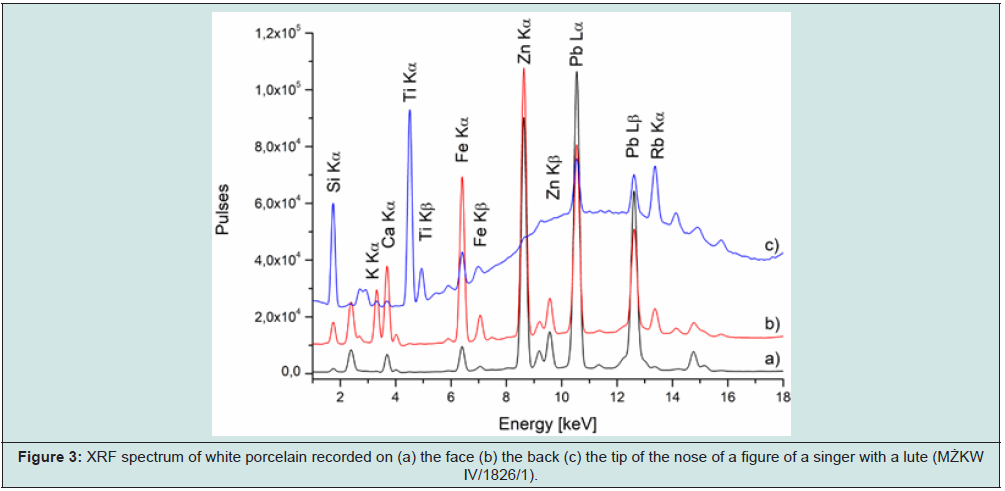
Iron, zinc and lead were found in the red pigment applied to the lute maker’s mouth and to his waistcoat, indicating the use of iron oxide-based paint. The mouth was repainted, probably during the conservation of the figurine in the 20th century. This is evidenced by the outline of the mouth, as well as the teeth, visible in the underside layer of paint, covered by a later paint job. The brown eyes and the lute were made using paints based on manganese (Kα 5.9 keV line) and iron compounds. In addition, zinc and lead were found to be present. High levels of manganese, and iron, together with cobalt (Kα 6.9 keV; Kβ 7.6 keV lines), zinc and lead were detected in black areas such as the pupil of the eye, the collar, miner’s skin and shoes. Chromium (Kα 5.4 keV; Kβ 5.9 keV lines), copper (Kα 8.0 keV; Kβ 8.9 keV lines), zinc, lead and some cobalt were found in the green miner’s cap (Figure 4). This is indicated by the use of copper pigment and chromium pigment, which was used in the Meissen porcelain manufactory from 1817 onwards. A similar composition of the green paint used in the restoration process was also found in the leaves on the pedestal. In addition, antimony (Lα, Lβ, and Kα, Kβ lines at 3.6, 4.1 and 26.3, 29.7 keV) appeared sporadically, indicating an admixture of Naples yellow.
The figure of a miner playing a triangle
Digital radiography of the figurine of a miner playing the triangle (inv. no. MŻKW IV/1826/2) showed that the head of the figurine has been reattached to the body. It is filled internally with clay and has no free space in the centre connecting to the hollow interior of the miner’s torso. An X-ray showed small internal cracks in the figure, mainly in the torso and pedestal area. These cracks are not visible under visible light, suggesting that they have been repaired during conservation treatments. Also under UV light, a slight luminescence of the hair is visible, indicating that this fragment was created later, while a high coherence of the object is visible for the other areas of the examined figurine under ultraviolet light.
XRF analysis showed that the studied figurine was made of white clay containing silicon and aluminium (Kα 1.5 keV), rich in potassium, calcium and iron. In addition, traces of manganese, zinc, lead and rubidium (Kα 13.4 keV; Kβ 15.0 keV lines) were found. The same material was detected on the miner’s face near the mouth, back, hand, leg below the knee and on the pedestal. The elemental composition detected indicates the 18th century origin of the figurine. The red areas, such as the mouth and part of the doublet, were painted with red iron oxide-based paint. An admixture of lead was also found in the elements examined, while no zinc was detected, confirming the dating. The green miner’s cap was painted with a substance characterised by a high content of chromium and zinc, with admixtures of iron and cobalt. This indicates that the examined fragment of the figurine dates from a later period. The yellow flower on the cap, in addition to Naples yellow containing antimony and lead, had a high zinc content, confirming the later manufacture of the analysed piece. The brown eyes with black pupils were also painted secondarily. The brown paint has a high zinc and lead content in addition to iron. Examination of the elemental composition of the miner’s grey hair revealed the presence of tin, iron and lead, as well as a trace content of chromium. This may indicate a later alteration of the upper fragment in the 20th century.
Contemporary paint glazing containing titanium was detected on the miner’s cheeks, the hand holding the triangle, the back or the folds of the miner’s uniform. This treatment was done deliberately during the conservation process to visually merge and give a uniform form to the whole figure. The titanium admixture present in this paint does not cause luminescence under UV light, unlike the titanium in the putty used to fill the cavities and reconstruct the figurine of the singer with lute (inv. no. MŻKW IV/1826/1). The black miner’s leather, kneepads and shoes were painted with black paint containing cobalt, iron, manganese and lead. The yellow centre of the flowers placed on the pedestal showed the presence of Naples yellow, while no zinc was recorded, as in the case of the flower on the cap, confirming the 18th-century origin of the figurine. Tin (Lα, Lβ, and Kα, Kβ lines at 3.4, 3.9 and 25.3, 28.5 keV) and gold (Lα 9.7 keV; Lβ 11.5 keV lines), were detected in the purple and pink flowers, indicating the use of Cassius’ purple. The blue petals of the flowers are painted with a cobalt-based paint with a touch of nickel and iron. This composition is characteristic of 18th-century cobalt paints. Only one of the sites examined additionally detected high levels of zinc and titanium from a 20th-century reconstruction of the damaged part of the flower petals. Similarly, the green leaves on the pedestal are painted with contemporary paint with high chromium and zinc content, with added iron and cobalt. The grey triangle held by the miner has also undergone restoration. This is evidenced by the purple ribbon, which has been painted with paint with a high content of titanium, iron and zinc.
The figure of a miner playing the flute
Figure 5: XRF spectrum of gilded miner’s emblem recorded on a figure of a miner playing the flute (MŻKW IV/1826/3).
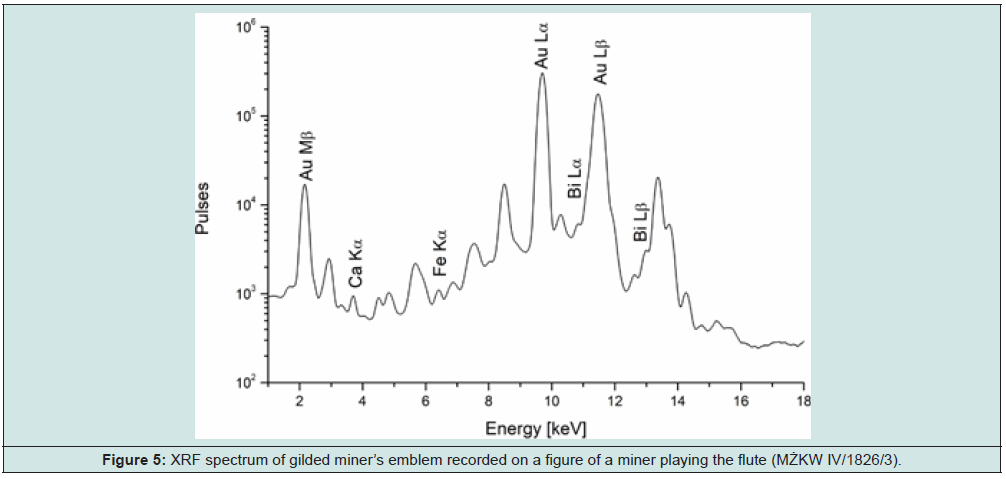
Radiographs of the figure of a flute-playing miner (inv. no. MŻKW IV / 1826/3) indicate a high degree of integrity of the examined object. Probable repairs included only a fragment of the miner’s skin, while the rest of the miner’s figure bears no signs of interference. Similarly, under UV light, the figurine does not show a specific luminescence that would indicate the repairs made. Among the six objects examined, the flute player’s form in the ultraviolet field shows the least variation, exhibiting no localised discolouration. The examined figurine is also distinguished by a concave bottom. XRF analysis showed that the investigated figurine was made of white clay rich in zinc, calcium, potassium, and iron, with traces of titanium, rubidium and manganese. The same elemental composition was found on the face, white blouse sleeve, hand, leg and pedestal. The high zinc content indicates that the figurine was made in the 19th century. The observed concave bottom of the figurine seems to confirm its later creation. The green cap on the miner’s head was painted with a chrome pigment-based paint. In addition, a high content of zinc, iron and cobalt were found. The gilded miner’s emblem was covered with bismuth-doped gold (Bi Lα 10.8 keV; Lβ 13.0 keV lines) (Figure 5).
Antimony, lead and zinc were detected in the yellow ornament on the cap, indicating Naple’s yellow. The red lips and waistcoat were painted with oxide paint containing iron, zinc and lead. The miner’s grey hair was covered with paint containing iron, manganese, chromium, cobalt, lead and zinc. The eyes were painted brown with paint containing iron, zinc, rubidium, zirconium and lead. High levels of manganese, iron, cobalt, lead, chromium and zinc were detected in the black pupils. High levels of chromium and zinc were also found in other black areas, such as the miner’s leather at the belt and kneepad, confirming the 19th-century dating of the studied figure. The examination of the yellow flower placed on the pedestal indicated the same results as for the ornament on the cap. The blue paint used to cover the flowers on the pedestal had a high content of iron, cobalt, zinc and lead, as well as titanium, chromium, nickel and rubidium. The green leaves had a high content of chromium, copper, zinc, lead and iron and an admixture of antimony, and cobalt, indicating the use of green paint containing a mixture of chromium, and copper pigments with Naples yellow.
The chief/mining administrator figure
X-rays of a figure of a chief/mining administrator (inv. no. MŻKW IV/1826/4), showed that the upper part of the figure is consistent. In the region of the head and upper torso, no traces of repairs were found. The digital radiograph clearly shows a reconstruction of the right corner of the pedestal and repaired cracks and cavities on the back of the pedestal. Repairs are visible in the following areas: the sword handle, a fragment of the miner’s black cloak and the right thigh and right ankle. Under UV light, the object retains a characteristic slight local variation in luminescence. XRF studies showed that the figurine was originally made of clay, rich in potassium, and calcium, with added iron, manganese, and lead. High levels of zinc were detected on the elbow, leg and pedestal, suggesting later repairs. Iron and lead were detected in the miner’s red mouth and waistcoat, indicating the use of iron oxide-based red paint. In addition, zinc was found in the mouth, indicating that it had been repainted. Iron and manganese were detected in the brown outline of the miner’s eyes, indicating the use of umber.
Figure 6: XRF spectrum of black pupils recorded on a figure of a chief/mining administrator (MŻKW IV/1826/4).
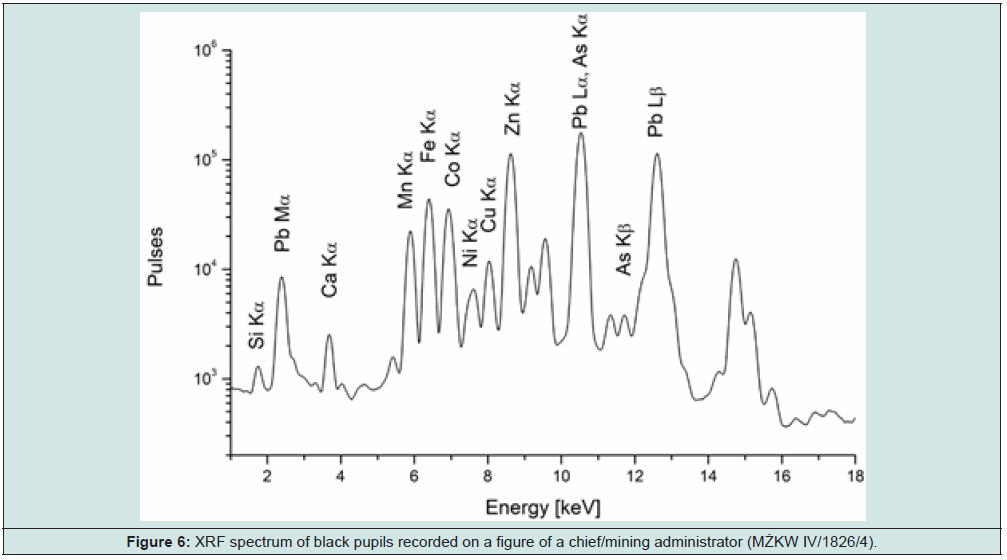
The black pupils were marked with a paint composed of manganese, iron, cobalt, zinc, and lead with addition of copper, nickel (Kα 7.5 keV; Kβ 8.3 keV lines), and arsenic (Kα 10.5 keV; Kβ 11.7 keV lines) (Figure 6). The presence of zinc indicates repainting. A similar elemental composition was found on the black kneepad, miner’s leather and shoe. The green chief’s cap was originally painted with a paint containing copper, iron and cobalt. A chromium pigment with a high zinc content was used for the secondary painting. The same pigment was used on the green leaves on the pedestal and in the translucent glaze layer. The light brown axe handle was found to contain iron, zinc, lead and an admixture of manganese and antimony, identifying the paint composition as a mixture of iron oxide and Naples yellow. The high zinc content indicates that the piece was painted at a later date. The buttons of the mantle were gilded using gold doped with lead and iron. The analyses carried out indicated that areas such as the head and torso date from the 18th century, while other elements were completed or modified.
The senior foreman figure.
X-rays of the figure of the senior foreman (inv. no. MŻKW IV/1826/5) showed that the whole figure is coherent and shows no signs of serious damage. Only within the black miner’s skin can inhomogeneities and small cracks be seen, which may indicate repairs to this fragment. Photographs taken under UV light revealed a distinct greenish luminescence of some parts of the figurine. The rest of the object shows few localised changes in luminescence, which are not indicative of repairs, but of the original heterogeneity of the miner’s figurine material. It was made of white clay rich in potassium, calcium and iron, with an admixture of rubidium, manganese and lead. Iron oxide paint was used to paint the miner’s red mouth. The lack of signal from the zinc indicates that this is an original 18th-century object. In the pink cap, in addition to potassium, calcium, iron and lead, manganese, zinc, rubidium, tin and gold were found, suggesting the use of Cassius purple (Figure 7). In the green cap bottom, high levels of chromium, iron, zinc, tin and lead were found along with additions of cobalt, nickel, copper and antimony. The elements detected may suggest the original use of green paint based on copper and cobalt compounds, with the addition of Naples yellow, which was subsequently repainted with a layer of paint high in chromium and zinc.
High levels of chromium, iron and zinc were detected in the brown irises of the eyes, indicating the use of a later paint based on chromium and iron compounds. Analysis of the black paint on the whiskers revealed the presence of manganese, iron, cobalt and lead. In addition to the previously mentioned elements, traces of tin and gold were also detected in black areas such as the shoe, suggesting the addition of Cassius’ purple to the black paint. These types of paint combinations were used in the 18th century to achieve gradations of black shades or to deepen the effect of threedimensional modelling. In addition to iron, manganese, cobalt and lead, high levels of zinc and an admixture of uranium (Lα 13.6 keV; Lβ 16.4 keV lines) were found in other black sites, such as the kneepad and miner’s leather (measured next to the sabre blade). The elements detected clearly indicate that these sites were subject to repairs or secondary modifications. Similarly, traces of uranium were observed in fragments of green leaves on the pedestal (Figure 8).
Figure 8: XRF spectrum of green leaves on the pedestal recorded on a figure of the senior foreman (MŻKW IV/1826/5).
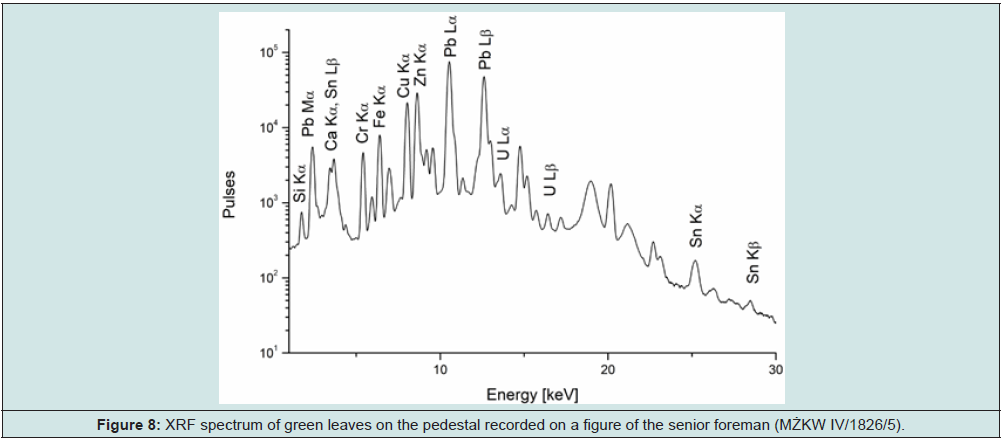
The presence of these repairs is visible in digital radiography and under UV light, in which the uranium content produces a greenish luminescence, characteristic of glass doped with this element. The modification was made no earlier than the second half of the 19th century, as glass doped with uranium compounds was widely used from the 1840s onwards. The addition of green leaves also confirms the presence of chromium, zinc and copper in the green paint layer. Antimony, lead, iron and zinc were found in the yellow flower placed on the plinth, in the yellow centre of the blue flower and in the yellow ornament on the cap, indicating reconstruction or secondary repainting with Naples yellow paint. Similarly, the blue flower on the pedestal was painted using a cobalt-rich pigment, but the high zinc content precludes its dating to the 18th century.
The figure of a digger
Digital radiography of the digger figurine (inv. no. MŻKW IV/1826/6) showed a reconstruction of the miner’s left hand and minor repairs to the miner’s plinth and black leather. In addition, X-rays show that the head has been reattached to the figurine. Also, an ultraviolet photograph of the object suggests that the miner’s head has been significantly modified and probably reconstructed from fragments of the original porcelain. The overall UV image of the object does not differ from other figures dating to the 18th century. XRF analysis showed that the figurine was made of white clay containing silicon, potassium, calcium, iron and admixtures of manganese, nickel, rubidium, titanium and lead. Barium (Lα, Lβ, and Kα, Kβ lines at 4.4, 4.8 and 32.2, 36.4 keV) and zirconium (Kα 15.8 keV; Kβ 17.7 keV lines) also appeared sporadically in some places, but these elements were present in Meissen porcelain made in the 18th century. Analysis of the red lips revealed the presence of elements such as iron, potassium, calcium and lead, as well as small amounts of rubidium, zirconium and barium, confirming the dating. The brown eyes were painted with a pigment containing iron, zinc and lead and the addition of manganese, titanium and cobalt. The black pupils were coated with paint containing manganese, iron and cobalt compounds, with chromium, zinc and lead added. The high zinc content in both the brown iris and the black pupil of the eye indicates that they have been repainted. This is further confirmed by the chromium detected in the pupil. A similar elemental composition was found in the hair. In addition to high levels of manganese, iron, lead, calcium and potassium, chromium, cobalt, zinc, rubidium and zirconium were found in the grey-black curls. This may suggest some secondary alteration of the study area.
The black miner’s outfit, i.e. the doublet, kneepads, miner’s leather and shoes, were painted with paint containing manganese, iron, cobalt and lead with additions of nickel, copper, zinc and rubidium. The trace zinc content detected in the test areas indicates that the figure was made in the 18th century. The gilding on the uniform was made using gold and iron. The green miner’s cap contains high levels of chromium, zinc and lead, indicating its recent dating. High contents of zinc, lead and antimony were found in the yellow ornament on the cap, covered with paint containing Naples yellow. All of these treatments on the figurine confirm repairs to the miner’s head region. The yellow flower placed on the pedestal received a similar treatment. The area analysed was found to contain high levels of zinc, titanium, antimony and lead. The elements detected indicate a contemporary restoration using Naples yellow. Paint based on chromium pigment with zinc, lead and antimony was found on the green leaves on the pedestal. Obtained origin of colour from chromium pigment and Naples yellow. The blue flower on the pedestal had a high content of cobalt, zinc and lead and an admixture of iron, chromium and titanium. The elemental composition of the area studied indicates the introduction of later additions and modifications to the decoration placed on the pedestal.
Results & Discussion
Although the XRF technique is categorised as surface analysis, it must be remembered that X-rays penetrate several layers of ceramic decoration. This can present difficulties in distinguishing between elements detected from different layers. To determine which elements belong to the coloured decorations, the spectra of the coloured glaze were compared with those of the white body. Elements in deeper layers can be also identified by detecting inversions of high-energy lines and low-energy X-ray line intensities, taking advantage of the fact that lower-energy lines are more strongly attenuated for buried elements. The results of the elemental composition tests for selected measuring points are summarized in Table 1. The research on Meissen porcelain and the components used for dyeing has been the subject of research by several researchers [9,19,20]. The results obtained in the studies do not differ from the information available in the literature. The technical aspects of porcelain production in Meissen are described in the literature, which makes it possible to systematize the paint or gilding recipes used and date the objects on their basis. The analysis of the figures allowed to distinguish between parts made in the 18th century and later. In the case of the 19th-century figurine, there is a marked band indicating the presence of zinc. The presence of zinc is traditionally associated with decorations in the 19th century.
Also by considering the chemical composition of some of the coloured pigments used, it is possible to distinguish the period when they were used. According to recipes from 1731 used in the Meissen manufactory and collected in Höroldt’s book, yellow paints on objects from the 18th century contain lead and antimony. This is evidence of the use of Naples yellow (Pb2Sb2O7). In the case of the 18th-century figurine of a miner playing the triangle (inv. no. MŻKW IV/1826/2) the yellow centre of the flowers showed the presence of lead and antimony indicating the presence of Naples yellow. Different levels of iron were also noted in glazing from this period. This could be due to the use of red iron oxide in warmer shades. For the same figurine yellow flower on the cap, beside Naples yellow contains high zinc content, indicating the later manufacture of the analysed piece.
Studies of the blue enamel of 18th century, ranging from light blue to dark blue, showed that they were rich in cobalt. The blue petals of the flowers placed on the pedestal of the figurine of a miner playing the triangle (inv. no. MŻKW IV/1826/2) are painted with a cobalt-based paint with a touch of nickel and iron. The technique of making blue underglaze decorations was studied since the beginning of the production of Meissen porcelain using cobalt ores from the Ertzgebirge Mountains. The first success in this regard was attributed to David Köhler in 1719 [10,21]. The presence of nickel, iron, arsenic, manganese and potassium in them is often noted. Copper is present only sporadically, or no present. Based on studies of Meissen porcelain carried out in other research centres, it can be concluded that only green-blue (turquoise) enamels are rich in copper and contain significant levels of cobalt [9]. Traces of zinc are rare, reported in medium and dark blues. Tin is also present in opaque decorations during this period. According to Höroldt’s recipes from 1731, blue paint was prepared from cobalt carbonate, blue-green by mixing copper oxide or brass ash with cobalt carbonate, the so-called India blue from a mixture of cobalt carbonate and potassium bitartrate, and sea green by mixing India blue with brass ash. In 1731, Höroldt noticed that the addition of zinc to cobalt blue softened its sharp blue shade.
Analysis of green enamel indicated the presence of chromium in all the figures tested. In the case of the 18th-century figurines, the presence of chromium is due to the conservation process. In the later 19th-century objects, it may be due to both the production process itself and later restorations. In the case of the 18thcentury figure of the senior foreman (inv. no. MŻKW IV/1826/5), in the green cap bottom, high levels of chromium, iron, zinc, tin and lead were found along with additions of cobalt, nickel, copper and antimony. The elements detected may suggest the original use of green paint based on copper and cobalt compounds, with the addition of Naples yellow, which was subsequently repainted with a layer of paint high in chromium and zinc. In the case of 19th century figurine of a singer with a lute (inv. no. MŻKW IV/1826/1) chromium, copper, zinc, lead and some cobalt were found in the green miner’s cap. This is indicated by the use of copper pigment and chromium pigment, which was used in the Meissen porcelain manufactory from 1817 onwards.
Originally, in the Meissen porcelain manufactory, green paints were prepared using copper compounds. “Grass Green” enamel recipe documented by Höroldt at Meissen was described as green copper (II) sulfate mixed with Naples yellow. Green was also used consisting of blue cobalt compounds and Naples yellow. These technologies also survived in the 19th century. Following the introduction of the green chrome-based paints listed as an ingredient in Meissen enamels from 1817, chrome-based green pigments were combined with copper green pigments to create an intense green paint with high opacity. In the pink enamel (the purple and pink flowers placed on the pedestal of 18th-century figure of a miner playing the triangle (inv. no. MŻKW IV/1826/2)), tin and gold were detected, indicating the use of Cassius’ purple. Originally a colloidal gold compound based on tin hydroxide, was used in the production of ruby glass, but soon found use in the production of pink to burgundy-coloured enamels to decorate ceramics and porcelain. The discovery of this preparation is attributed to Andreas Cassius of Leyden. He or his son in 1685 published a description of the production method and applications in a book entitled De Auro. Around 1679 colloidal gold compounds were used by Johann Kunckel at the famous Potsdam glassworks to produce ruby glass [22]. Later, Cassius purple was mainly used to obtain various shades of pink and purple, from light pinkpurple to dark lavender in porcelain enamel, which is identified by the presence of tin and gold, as it is colloidal gold formed during oxidation/reduction reactions with tin salts.
Studies of the red areas, such as the mouth and part of the doublet of 18th-century figurine of a miner playing the triangle (inv. no. MŻKW IV/1826/2) indicated the iron compounds used for pigmentation of red enamels. In Meissen porcelain, red shades ranging from orange to burgundy were obtained from iron (III) oxide (Fe2O3) pigment dissolved in lead silicate, however the preparation was difficult due to very small grains were required. According to recipes from 1731, brown paints were prepared from umber or a mixture of umber, Neapolitan yellow, and red iron pigment, therefore the main elements detected in them are manganese and iron. Analysis of brown outline of the miner’s eyes in the a figure of a chief/mining administrator (inv. no. MŻKW IV/1826/4) indicated the presence of iron and manganese, typical for the use of umber. In the case of 19th century figurine of a singer with a lute (inv. no. MŻKW IV/1826/1), the brown eyes and the lute were made using paints based on manganese and iron compounds. In addition, zinc and lead were found to be present. Research by F. Casadio showed that two 19th century brown glazed products contained high levels of iron, cobalt, and copper. In addition, in the nineteenth century brown enamels mixed zinc-lead fluxes were also identified [9].
Two types of paint obtained from cobalt, umber, and manganese ore deposits were used in the black decorations produced in Meissen in the 18th century: the first one obtained from manganese black and cobalt, and manganese and iron black. Occasionally, in the 18th-century black produced in Meissen, tin or gold derived from Cassius purple was observed. This type of black decoration was noted for the 18th-century figure of the senior foreman (inv. no. MŻKW IV/1826/5). Examination of the black paint on the whiskers revealed the presence of manganese, iron, cobalt and lead. In addition to the previously mentioned elements, traces of tin and gold were also detected in black areas such as the shoe, suggesting the addition of Cassius’ purple to the black paint. In later decorated objects, also mainly cobalt, manganese, and iron were detected, but with an admixture of chromium and zinc. High levels of chromium and zinc were found in black areas, such as the miner’s leather at the belt and kneepad, confirming the 19th-century dating of the figure of a flute-playing miner (inv. no. MŻKW IV/1826/3). The black pupils of in the a figure of a chief/mining administrator (inv. no. MŻKW IV/1826/4) were marked with a paint composed of manganese, iron, cobalt, zinc, and lead with addition of copper, nickel and arsenic. Detected elements indicates later repainting.
Gilded decorations on Meissen porcelain objects dated around 1715-47 contain high levels of gold and lead, and trace amounts of nickel, sometimes with an admixture of silver, zinc, and copper. Frit containing lead oxide as a flux was used by Höroldt from 1731. The high-quality gold powder used in Meissen for gilding, was almost free of impurities, as it was obtained by dissolving Dutch ducats (containing about 98.7% gold in 1731) in aqua regia with the addition of iron sulphate. Fluxes containing bismuth oxide were used in gilding after 1770-75. Platinum was used for gilding in the last decade of the 18th century. The presence of repairs containing the uranium glass was noted in the figure of the senior foreman (inv. no. MŻKW IV/1826/5). The time of origin of the modifications is unknown, but it is assumed that they were made no earlier than the second half of the 19th century. Lole noted that the earliest reports of glass containing uranium date back to 1817 in a book of C. S. Gilbert’s ‘An Historical Survey of The Country of Cornwall’, which stated that uranium oxides gave glass its bright colour [23]. In the 1830s, Bohemian glassmaker Franz Anton Riedel (1786- 1844) began producing uranium glass. During this time, uranium glass production was also carried out in France and England [24- 28]. Colomban also mentions that lead uranate (PbUO4) was used for golden yellow enamels in porcelain produced in Sèvres [17]. Glass doped with uranium compounds was widely used from the 1840s onwards [24].
Conclusion
Laboratory analysis of the figures allowed to distinguish between elements made in the 18th century and later. In the case of a figurine of a singer with a lute (inv. no. MŻKW IV/1826/1), the high zinc content in most of the analyzed white areas dates back to the 1830s. In another of the examined figures - a miner playing the triangle (inv. no. MŻKW IV/1826/2), the detected elemental composition indicates an 18th-century design. The figure of a miner playing the flute (inv. no. MŻKW IV/1826/3), similarly to the figure of a singer with a lute (inv. no. MŻKW IV/1826/1), comes from the 19th century, which is indicated by the detected high zinc content. Other objects: a figure of a chief/mining administrator (inv. no. MŻKW IV/1826/4), a figure of the senior foreman (inv. no. MŻKW IV / 1826/5) and a miner digger (inv. no. MŻKW IV/1826/6) are objects created in the 18th-century. Their further fate influenced later repairs and current modifications.
References
- Ardid M, Ferrero JL, Juanes D, Lluch JL, Roldán C (2004) Comparison of total-reflection X-ray fluorescence, static and portable energy dispersive X-ray fluorescence spectrometers for art and archeometry studies. Spectrochimica Acta Part B Atomic Spectroscopy 59(s10-11): 1581-1586.
- Mantle M, Schreiner M (2000) X-ray Fluorescence Spectrometry in Art and Archaeology. X-Ray Spectrometry 29(1): 3-17.
- Moioli P, Seccaroni C (2000) Analysis of Art Objects Using a Portable X-ray Fluorescence Spectrometer. X-Ray Spectrometry 29(1): 48-52.
- Doleżyńska Sewerniak Ewa, Jendrzejewski Rafał, Klisińska Kopacz Anna, Sawczak Mirosław (2020) Non-invasive spectroscopic methods for the identification of drawing materials used in XVIII century. Journal of Cultural Heritage 41(1): 34-42.
- Klisińska Kopacz Anna (2015) Non-destructive characterization of 17th century painted silk banner by the combined use of Raman and XRF portable systems. Journal of Raman Spectroscopy 46(3): 317-321.
- Walcha O (1981) Meissen porcelain (Ed: H. Reibig) GP Putnam’s Sons, New York, USA.
- Schuster B (1996) Meissen. Geschichten zur Geschichte und Gegenwart der ältesten Porzellan-Manufaktur Europas, Orbis Verlag, München, Germany.
- Klisińska Kopacz Anna, Ochniak Dudek Klementyna, Wilkosz Tomasz (2021) Six sculptures of the miners-series made in the Meissen porcelain manufactory in the collection of the Cracow Saltworks Museum in Wieliczka-history and research. Studies and Materials for the History of the Saltworks in Poland 35(1): 300-387.
- Casadio Francesca, Bezur Aniko, Domoney Kelly, Eremin Katherine, Lee Lynn, et al. (2012) X-ray fluorescence applied to overglaze enamel decoration on eighteenth- and nineteenth-century porcelain from central Europe. Studies in Conservation 57(Sup 1): S61-S72.
- Colomban Phillipe, Milande Veronique (2006) On-site Raman analysis of the earliest known Meissen porcelain and stoneware. Journal of Raman Spectroscopy 37(1): 606-613.
- Domoney K, Shortland AJ, Kuhn S (2012) Characterization of 18th-century Meissen porcelain using SEM-EDS. Archaeometry 54(3): 454-474.
- Neelmeijer C, Pietsch U, Ulbricht H (2014) Eighteenth-century Meissen porcelain reference data obtained by proton-beam analysis (PIXE–PIGE). Archaeometry 56(4): 527-540.
- Tite MS, Bimson M (1991) A technological study of English porcelains. Archaeometry 33(1): 3-27.
- Turco F, Davit P, Maritano C, Operti L, Fenoglio G, et al. (2016) XRF Characterization Of 18th Century Piedmontese Porcelains From The Palazzo Madama Museum (Torino, Italy). Archaeometry 58(5): 765-778.
- Edwards Howell GM (2020) 18th and 19th Century Porcelain Analysis: A Forensic Provenancing Assessment. Springer Nature, Switzerland.
- Bezur Aniko, Casadio Francesca (2012) Chapter 8 - The Analysis of Porcelain Using Hand-Held and Portable X ray Fluorescence Spectrometers. In Handheld XRF for Art and Archaeology (Ed: AN Shugar, JL Mass). Leuven University Press, Leuven, Belgium pp. 249-312.
- Colomban Phillipe, Sagon Gerard, Faurel Xavier (2001) Differentiation of antique ceramics from the Raman spectra of their coloured glazes and paintings. Journal of Raman Spectroscopy 32(5): 351-360.
- Beauvoit Emmie, Cantin N, Lemasson Q, Chapoulie R, Amara AB (2022) Archaeometric Characterization of the Industrial Production of Porcelains in the Vieillard & Co. Manufactory (Bordeaux, France, 19th Century). Materials 15(15): 5311-5330.
- Mields M (1963) Die Entwicklung der Aufglasurpalette des europäischen Hartporzellans bis 1731 mit besonderer Berucksichtigung der Arbeiten von Johann Gregorius Hörold Keramische. Zeitschrift 15(1): 453-459.
- Ullrich B, Lange P, Friedmar K (2010) Thüringer und Meissener Porzellan des späten 18. und frühen 19. Jahrhunderts-ein werkstoffhistorischer Vergleich. Keramische Zeitschrift 62(3): 185-190.
- von Hornig Sutter M (1985) Miesener Porzellane des 18. Jahrhunderts im Visier von Kunstgeschichte und Naturwissenschaft Weltkunst 55(1): 110-115.
- Hunt LB (1981) Gold based glass and enamel colours. Endeavour 5(2): 61-67.
- Lole F Peter (1995) Uranium Glass in 1817 - A Pre-Riedel Record. Journal of Glass Studies 37(1): 139-140.
- Strahan D (2001) Uranium in Glass, Glazes and Enamels: History, Identification and Handling. Studies in Conservation 46(3): 181-195.
- Landa E, DiSantis D (1993) A brief history of radioactive glassware. Radiographics 13(3): 697-699.
- Marshall J (1998) Glass Source Book: A Visual Record of the World’s Great Glassmaking Tradition. Quantum Books Ltd, London, England.
- Philips P (Ed.) (1987) The Encyclopedia of Glass. Springs Books, London, England.
- Klein D, Lloyd W (1997) The History of Glass. Tiger Books International, London, England.

Top Editors
-

Mark E Smith
Bio chemistry
University of Texas Medical Branch, USA -

Lawrence A Presley
Department of Criminal Justice
Liberty University, USA -

Thomas W Miller
Department of Psychiatry
University of Kentucky, USA -

Gjumrakch Aliev
Department of Medicine
Gally International Biomedical Research & Consulting LLC, USA -

Christopher Bryant
Department of Urbanisation and Agricultural
Montreal university, USA -

Robert William Frare
Oral & Maxillofacial Pathology
New York University, USA -

Rudolph Modesto Navari
Gastroenterology and Hepatology
University of Alabama, UK -

Andrew Hague
Department of Medicine
Universities of Bradford, UK -

George Gregory Buttigieg
Maltese College of Obstetrics and Gynaecology, Europe -

Chen-Hsiung Yeh
Oncology
Circulogene Theranostics, England -
.png)
Emilio Bucio-Carrillo
Radiation Chemistry
National University of Mexico, USA -
.jpg)
Casey J Grenier
Analytical Chemistry
Wentworth Institute of Technology, USA -
Hany Atalah
Minimally Invasive Surgery
Mercer University school of Medicine, USA -

Abu-Hussein Muhamad
Pediatric Dentistry
University of Athens , Greece

The annual scholar awards from Lupine Publishers honor a selected number Read More...




